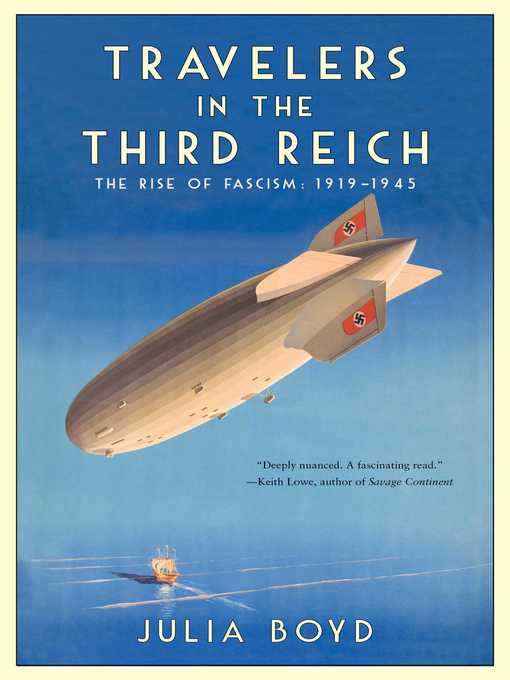
Travelers in the Third Reich
کتاب های مرتبط
- اطلاعات
- نقد و بررسی
- دیدگاه کاربران
نقد و بررسی

June 1, 2018
Nazi Germany, tourist destination? Yes, by this account--and, by 1937, a destination of choice for a half-million Americans per year."You did not have to be pro-Nazi to marvel at the green countryside, the vineyard-flanked rivers or the orchards stretching as far as the eye could see." So notes Boyd (The Excellent Doctor Blackwell: The Life of the First Woman Physician, 2013, etc.) of the vast, lucrative trade marketing Germany under the Third Reich to non-German visitors, a trade that had begun in earnest immediately after World War I ended. It helped to hold those views or at least believe, as did British aristocrat Violet Bonham Carter, that "the reparations policy insisted on by France...was morally unjust and politically mad." Carter was traveling to a grimy, still-staggering Germany in 1923, and during that and the following decade, many Britons and Americans came to Germany to enjoy the bohemian liberties depicted by Christopher Isherwood in the stories that would underlie the stage play Cabaret. Some of those Britons took pains to avoid dreadful middle-class people, "however nice they are," and to stay among "one's own kind," as another aristocrat wrote to the folks back home. Some of Boyd's portraits involve men and women whose firsthand views of Germany would harden their opposition to Nazism--including, surprisingly, the poet and playwright Samuel Beckett, who endured "freezing weather, lack of money, rain and leaking shoes" to report on the place with much less enthusiasm than Graham Greene. Boyd also adds a dimension to a well-known tale by noting Hitler's famed refusal to shake the hand of African-American athlete Jesse Owens--but adding that ordinary Germans in the Olympic crowd "took the great black athlete to their hearts, chanting 'Oh-vens! Oh-vens' whenever he appeared." Even so, Boyd notes the still greater popular enthusiasm for the regime, concluding that returning visitors would have had no illusions, if honest with themselves, about the Nazis' true colors.A well-conceived study of a little-known corner of history.
COPYRIGHT(2018) Kirkus Reviews, ALL RIGHTS RESERVED.

June 25, 2018
For many foreign visitors, even after 1933, Germany was not “the Third Reich,” but rather a charming country with beautiful landscapes, women dressed in dirndls, and rustic gothic villages. To what extent could they see the horrors behind the tourist facade? British writer Boyd (A Dance with the Dragon: The Vanished World of Peking’s Foreign Colony) culls the impressions of nearly 200 short- and long-term travelers, almost all British and American, to examine this question. A few of them were well-known public or cultural figures, such as Charles Lindbergh and Samuel Beckett; most were largely unknown tourists, academics, students, diplomats, businesspeople, and athletes. A significant number were apolitical; a few were taken in by Nazism and Hitler, such as David Lloyd George, the former British prime minister, who called Hitler “the George Washington of Germany.” Boyd uncovers surprising facts, such as that “Dachau had become something of a tourist destination”—visiting diplomats were told the camps were for re-educating “undesirables” and Communists through work, and sometimes shown guards dressed as prisoners—and notes the handful of visitors who worked to aid Jews, such as the opera-loving sisters Ida and Louise Cook. Boyd offers no overriding thesis; instead, her book is a mosaic of impressions. This fresh, surprising perspective on how Nazi Germany was seen at the time will appeal to anyone looking for a new angle on that historical moment.

August 1, 2018
Looking back at the Nazis' rise to power before World War II, we wonder how they were allowed to build up to such terrible acts without much censure or resistance. Even outsiders, such as the many British and American tourists, students, businessmen, government officials, and artists who traveled to Germany, seemed to have turned a blind eye. It's their thoughts, feelings, and actions that Boyd (A Dance with the Dragon) brings to life, through their correspondence and other records, to offer an understanding of how U.S. and British travelers viewed Germany and to answer successfully the question of why even those who witnessed German propaganda often failed to outright condemn the actions of Hitler's regime. The author explores the feelings of kinship U.S. and British citizens felt toward Germans during and after World War I; their love of German culture and countryside; how confusing it was to interpret propaganda and define fascism; and the disbelief that the warm, hospitable Germans they met were capable of such heinous acts. VERDICT This compelling, intricate, and meticulous work of how outsiders viewed Hitler's Germany will appeal to readers of World War II and 20th-century history.--Heidi Uphoff, Sandia National Laboratories, NM
Copyright 2018 Library Journal, LLC Used with permission.

























دیدگاه کاربران